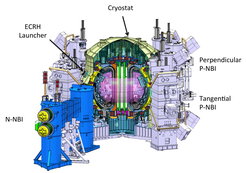Participation in JT-60SA
The Japanese-European tokamak project is considered the successor to JET. It is intended to support ITER in answering the open physical questions for the design of a DEMO reactor with continuous operation. IPP is helping to prepare the large-scale plant.
The JT-60SA project was initiated in 2007 as part of the "Broader Approach" agreement between the EU and Japan on the fastest possible use of fusion energy. The focus is on carrying out research projects complementary to ITER in the direction of developing a DEMO design. JT-60SA has the ultimate goal of achieving fully non-inductive, steady-state tokamak operation through high plasma pressure.

JT-60SA is the largest superconducting tokamak after ITER. This facility is capable of confining deuterium plasmas at the break-even point, achieving pulse lengths (typically 100 seconds) longer than the time scales that characterise key plasma processes such as current diffusion and particle recycling.
Construction of the machine in Naka, Japan, was completed in 2020. Commissioning is currently underway. The JT-60SA research plan developed together with ITER covers the lifetime of the facility of about 20 years.
The IPP and JT-60SA
EU contributions to the construction and technical-scientific operation of JT-60SA are coordinated by Fusion for Energy and EUROfusion. In collaboration with these organisations, the IPP contributes to the preparation and subsequent support of the JT-60SA operation. In IPP's Tokamak Scenario Development division, technological sub-systems for JT-60SA are being developed and set up for the control of disruptions and for the refilling of particles by means of cryogenic pellets.
